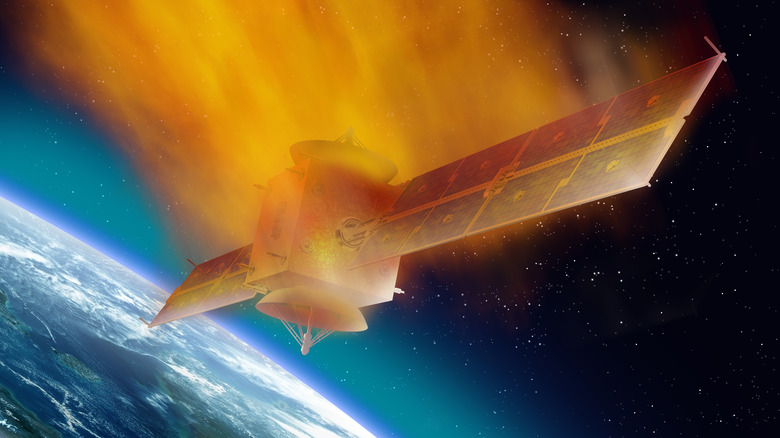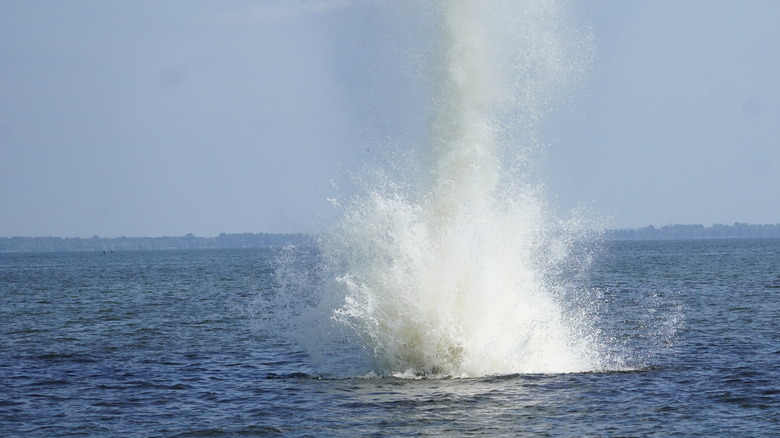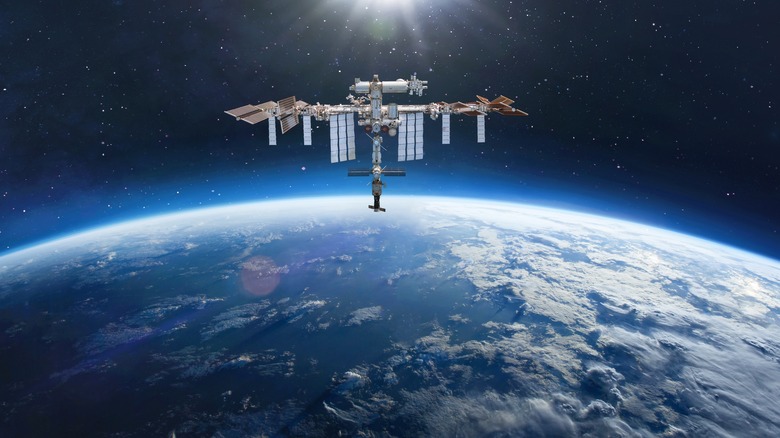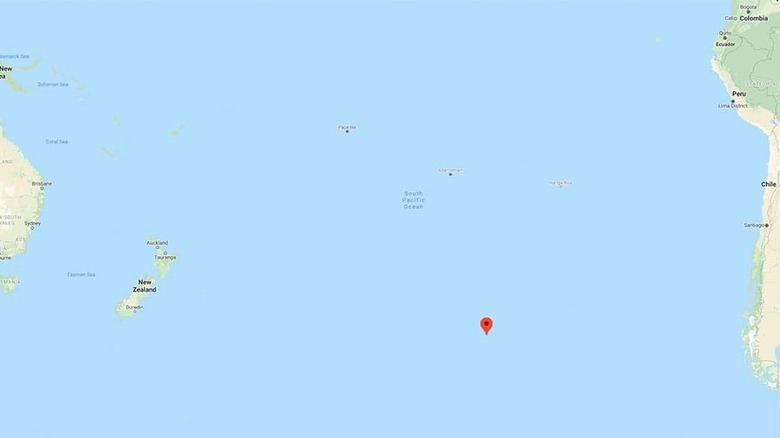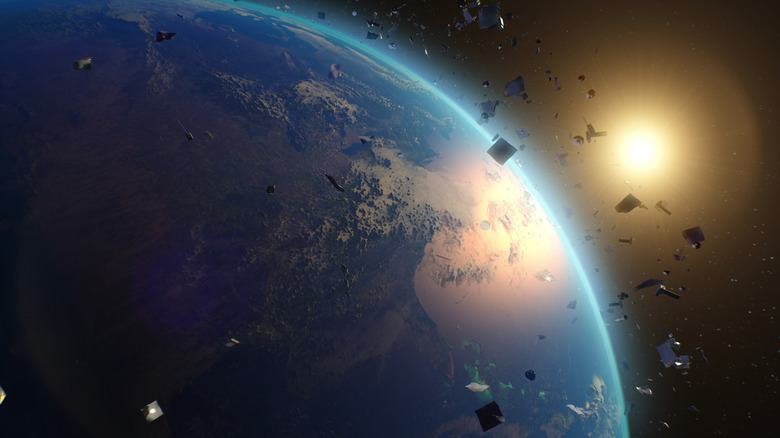This Is Where Satellites Go To Die
The sky is full of satellites, and they're central to modern life. The internet, GPS, and telecommunications all rely on the massive hunks of metal that are constantly orbiting the earth at thousands of miles per hour. More are being added every year, with Elon Musk's Starlink alone claiming to have over 6,000 active satellites as of early 2024.
But as with everything else, a satellite has a service life. After a set number of years, each satellite will have either fulfilled its purpose, or simply broken down after vital parts begin to fail. Some also break before their time and cannot be repaired. Space debris is already a problem, plus many satellites are in "low-earth orbit" and have to work to stay up in space. So, satellites tend to be "de-orbited" at the end of their run — which is a fancy way of saying they fall back to Earth.
The de-orbiting process is about as complex as everything else space-related when you dig into it. While malfunctions and mistakes do happen, the majority come back to earth in a controlled manner. While populated areas make up a tiny fraction of the globe, you still don't want to risk dumping a satellite on someone's house. Naturally, the safest thing to do is to aim for the most sparsely populated area on earth. This gives you plenty of wiggle room in case mistakes are made. The current final destination of choice for space debris is in the South Pacific Ocean, in an area jokingly called the "spacecraft cemetery."
There's a lot of space stuff at the bottom of the ocean
The place organizations like NASA aim at when de-orbiting a satellite is called Point Nemo — and it's about as remote as things get. To reach the nearest bit of land to the satellite graveyard, you'll need to travel 1,670 miles. If the scientists do mess up and hit this land, which is a cluster of small islands, then a bunch of tropical birds will have a very bad afternoon — but no humans will be harmed. They all live a lot further away. Ironically enough, the closest humans to Point Nemo are often the astronauts on board the International Space Station.
Scientists have been crashing spacecraft into this part of the world for around 50 years, and it really is an ideal spot. When you want to guide an object spinning at 17,000 miles per hour to a specific point on a ball that's spinning at roughly 1,000 miles per hour, it's best to build in some wiggle room. Still, while Point Nemo is probably the best spot to send your used satellites too, they don't all make it there. Some land in other large bodies of water such as a remote spot in the Indian Ocean. Smaller and less aerodynamic bits of space debris are also likely to burn up when re-entering Earth's atmosphere. But for one large and particularly famous orbiting object, Point Nemo is the most viable final resting place.
The ISS will land there one day
The International Space Station (ISS) is many things. It's a symbol of international cooperation, showing we can all get along and advance humanity's understanding of the universe when we want to. It's the largest man-made object ever put into orbit, and the second-largest object currently making its way around the Earth (the largest is the moon, obviously). But it too has a finite service life, and if everything goes as planned then the ISS will meet its end in 2030. As the European Space Agency points out, leaving something that large in orbit forever just isn't an option. So instead it will be brought back to earth, break up significantly upon re-entry, and if various space agencies have gotten the math correct, hopefully land in the world's most remote place and not on top of some Chilean bungalow.
It won't be the first space station to come to rest at Point Nemo. Russia's Mir space station met its end there, alongside the 300-or-so other bits of space junk currently littering the seabed of that part of the Pacific. Given the positives that come with Point Nemo, it's likely going to be the final resting place of whatever follows the ISS too — though there are some caveats that come with returning "space junk" to Earth.
Point Nemo is arguably the least harmful option
While not smashing various bits of debris into the planet we live on is arguably the ideal option, it's just not practical. Point Nemo is arguably the best place for space debris, and its remoteness isn't the only factor. While not harming human life is the main priority, and Point Nemo is as far as you can get from Earth-based humans, you're also unlikely to bother any plant or animal life there either.
Research has shown that ocean currents in the area are extremely weak. This limits the flow of nutrients into and around Point Nemo, and means any kind of life has a hard time surviving there. Those weak currents also limit the chances of anything undesirable leaking out from the space debris into more delicate ecosystems.
The UV rays hitting Point Nemo are also particularly intense, which again makes it difficult for plants, animals, and microbes to live in the area. So there's little chance of a lump of space station clocking a turtle, dolphin, or anything else we'd rather not bother further.
With that being said, there is one big problem Point Nemo can't solve. Scientists have observed aluminum particles in the air. They believe that the particles come from de-orbited satellites and other bits of space debris, and they are released before it hits the ocean. So, it's a problem wherever we're landing our space junk. There's an option that prevents this problem, but that isn't ideal either.
There is another option for some satellites
The South Pacific isn't the only final resting place for spacecraft. Some don't come back to Earth at all, though responsible companies and organizations still want the used spacecraft somewhere far from the satellites that are still actively orbiting Earth. A "graveyard orbit" involves shoving a disused satellite further out into space where it is less likely to cause any issues. Currently, that's around 200 miles further out into space than the furthest currently active satellite, or roughly 22,400 miles from the Earth's surface.
While the satellites that have been placed in a "graveyard orbit" aren't currently doing much harm, that could change in the future. The bit of space around Earth is getting very crowded, and that may only get worse. The satellites currently in a graveyard orbit are also far enough away to stay there pretty much indefinitely, so if we want to do anything about it and clean space up a little — we may have to send someone or something out to them. Potential issues could arise if we need to start using the bit of space currently occupied by dead satellites, or if a satellite collides with another satellite (or something else) and breaks into pieces. 200 miles isn't a lot in space terms, and certainly isn't far when you consider the speeds these things move at. That means a bit of high-speed debris could theoretically skew off in a direction we don't want it to and give other spacecraft a problem to contend with.
